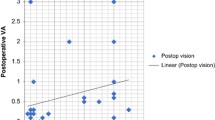Abstract
Background: Perfluorocarbon liquids are established tools for intraoperative hydrokinetic retinal manipulation. Because of their high specific gravity, however,they may well cause mechanical damage to the retina whenapplied as a long-term vitreous substitute.Perfluorohexyloctane, a semi-fluorinated liquid fluorocarbon of low specific gravity (1.35 g/cm3), was developed as a long-term vitreous substitute. The current study was performed to investigate intraocular tolerance to perfluorohexyloctane as a long-term vitreous substitute in the experimental animal. Methods: 34 vitrectomised eyes of pigmented rabbits underwent intravitreal injection of 1.0–1.2 ml perfluorohexyloctane or balanced salt solution. In 5 eyes the anterior chamber was filled. During the follow-up period of 3 months, the eyes were examined by slit lamp biomicroscopy, by fluorescein angiography and by electroretinography. The eyes were then enucleated and processed for light- and electron microscopy. Results: Perfluorohexyloctane depicted dispersion beginning between the first and third week. Over a period of 9 weeks no toxic effect on retina, lens and cornea was noticed. At 14 weeks ERG showed a slight decrease in amplitude and early morphological changes in the retina.Conclusion: Our findings suggest that perfluorohexyloctane is tolerated in the rabbit eye for 9 weeks. Since avascular rabbit retina is more susceptible to mechanical and toxic damage than vascularized primate retina, we suggest proceeding from here, and investigating tolerance and quality of tamponade of perfluorohexyl octane in man for up to 9 weeks.
Similar content being viewed by others
References
Clark LC. Description US Patent No. 4.490.351. 1984 Dec 25.
Bottoni F, Arpa P, Vinciguerra P, Zenoni S, Dc Molfetta V. Combined silicone and fluorosilicone oil tamponade (double filling) in the management of complicated retinal detachment. Ophthalmologica 1992; 204: 77–81.
Kirchhof B. Rueckblick Retina/Glaskoerper. Klin Monatsbl Augenheilkd. 1993; 203: 313–318.
Chang S, Zimmermann NJ, Iwamoto T, Ortiz R, Faris D. Experimental vitreous replacement with perfluorotributylamine. Am J Ophthalmol 1987; 103: 29–37.
Chang S, Sparrow J, Iwamoto T. Experimental studies of tolerance to intravitreal perfluoro-n-oktane liquid. Retina 1991; 11: 367–374.
Meinert H, Geister U. Semi-fluorinated compounds in Ophthalmology. J Vitreoretina 1992; 1: 31–35.
Meinert H. Fluorochemicals in Ophthalmology. International Conference ‘Fluorine in medicine’, Manchester 1994.
Velikay M. Stolba U, Wedrich A, Li Y, Datlinger P, Binder S. The effect of chemical stability and purification of per-fluorocarbon liquids in experimental extended-term vitreous substitution. Graefes Arch Clin Exp Ophthalmol 1995; 233: 26–30.
Meinert H. Requirements of perfluorocarbons for use in ophthalmology. J Vitreoretina 1992; 1: 5–16.
Sparrow JR, Ortiz R, MacLeish PR, Chang S. Fibroblast behaviour at aqueous interfaces with perfluorocarbon, silicone and fluorosilicone liquids. Invest Ophthalmol Vis Sci 1990; 31: 638–646.
Meinert, H. Semi-fluorinated alkanes and their use. PCT/WO 97/12852 09,08, 1996.
Ratiglia R, Berti E, Galimberti D, et al. Experimental vitreous replacement with perfluorophenanthrene. Eur J Ophthalmol 1997; 7: 59–63.
Han DP, Nande SK, O'Brien W, Guy J, Murray TG, Boldt HC. Evaluation of anterior segment tolerance to short-term intravitreal perfluoron. Retina 1994; 14: 219–224.
Jandeck C, Kellner U, Kraus H, Foerster MH. Electrophysiologic evaluation according to ISCEV standards in infants less than 10 years of age. Ophthalmologe 1997; 94: 796–800.
Pfeiffer RL, Pohm-Thorsen L, Corcoran K. Models in Ophthalmology and Vision Research. In: Manning PJ, Ringler DH, Newcomer CE (eds) The biology of the laboratory rabbit. Berlin, Heidelberg: Springer Verlag, 1994: 410–430.
Eckardt C, Nicolai U. Klinische und histologische Befunde nach mehrwöchiger intraocularer Tamponade mit Per-fluordekalin. Ophthalmologe 1993; 90: 443-447.
Winter M, Eckardt C, Havsteen B. Vitreous changes after contact with high-density substances. An in vitro experiment. Ger J Ophthalmol 1992; Suppl 1: 269.
Kobuch K, El Batarny A, Gabel VP. Wirkung von Silikonoel und Perfluorophenanthren (PFP) als Glaskorperersatzstoff auf das retinale Blutgefaess System des Kaninchens - Eine vergleichende Darstellung. Ophthalmologe 1997; (Suppl 1) 94: 189.
Fuchs B, Kobuch K, Klimant I, Op de Laad JP, Gabel VP. The influence of different synthetical vitreous substitutes on intravitreal oxygen tension, temperature and pressure. Invest Ophthalmol Vis Sci 1998; (Suppl) 39: 380.
Author information
Authors and Affiliations
Rights and permissions
About this article
Cite this article
Zeana, D., Becker, J., Kuckelkorn, R. et al. Perfluorohexyloctane as a long-term vitreous tamponade in the experimental animal. Int Ophthalmol 23, 17–24 (1999). https://doi.org/10.1023/A:1006444615412
Issue Date:
DOI: https://doi.org/10.1023/A:1006444615412




